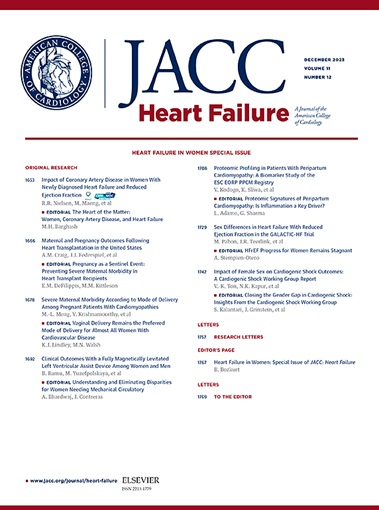通过血浆蛋白质组将慢性肾脏疾病与心力衰竭和不良心脏重构联系起来
IF 10.3
1区 医学
Q1 CARDIAC & CARDIOVASCULAR SYSTEMS
引用次数: 0
摘要
背景:循环血浆蛋白的研究可能揭示慢性肾脏疾病患者心力衰竭(HF)发展的分子途径。目的研究循环肾功能相关血浆蛋白与心衰发生风险的关系。方法:作者研究了正在进行的社区动脉粥样硬化风险纵向研究的参与者。使用适体测定法(Somalogic)测量了4,697种独特蛋白的相对血浆浓度。通过多变量线性和Cox回归模型,检测每种蛋白与肾小球滤过率(eGFR)、对数转化尿白蛋白与肌酐比(UACR)和心衰发生率的关系。慢性肾功能不全队列(CRIC)研究证实了蛋白与hf的相关性。双样本孟德尔随机化用于检验潜在的因果关系。结果在完全调整的模型中,在两次单独的ARIC研究访问中,44种血浆蛋白与eGFR或UACR以及事件HF相关,其中29种在CRIC中进行了外部验证。大多数血浆蛋白与HF相关,且射血分数保持不变,但与射血分数降低无关。这44个血浆蛋白中的一个簇与左室舒张末期容积指数和左室舒张功能障碍有关。孟德尔随机化提示高尔基膜蛋白1与HF和eGFR有因果关系。结论:本研究确定了44种eGFR和uacr相关血浆蛋白,这些蛋白与HF事件无关,独立于人口统计学、危险因素和肾功能。这些结果可能为未来预防和治疗心衰事件的治疗和生物标志物的开发提供信息。本文章由计算机程序翻译,如有差异,请以英文原文为准。
Linking Chronic Kidney Disease to Incident Heart Failure and Adverse Cardiac Remodeling Through the Plasma Proteome
Background
Investigation of circulating plasma proteins may reveal insights into molecular pathways that contribute to the development of heart failure (HF) among people with chronic kidney disease.
Objectives
The authors aimed to identify circulating kidney function–related plasma proteins that are associated with the risk of incident HF.
Methods
The authors studied participants of the ongoing longitudinal Atherosclerosis Risk In Communities study. Relative plasma concentrations of 4,697 unique proteins were measured with the use of an aptamer assay (Somalogic). Each protein was tested for associations with estimated glomerular filtration rate (eGFR), log-transformed urine albumin-to-creatinine ratio (UACR), and incident HF by means of multivariable linear and Cox regression models. Protein-HF associations were validated externally in the CRIC (Chronic Renal Insufficiency Cohort) study. Two-sample mendelian randomization was used to test for potential causal associations.
Results
In fully adjusted models, 44 plasma proteins were associated with either eGFR or UACR and incident HF at two separate ARIC study visits, of which 29 were validated externally in CRIC. Most plasma proteins were associated with HF with preserved ejection fraction, but not reduced ejection fraction. A cluster within these 44 plasma proteins were associated with larger left ventricular end-diastolic volume index and left ventricular diastolic dysfunction. Mendelian randomization suggests that Golgi membrane protein 1 is causally associated with HF and eGFR.
Conclusions
This study identified 44 eGFR- and UACR-related plasma proteins that are associated with incident HF independently from demographics, risk factors, and kidney function. These results may inform future therapeutic and biomarker development for the prevention and treatment of incident HF.
求助全文
通过发布文献求助,成功后即可免费获取论文全文。
去求助
来源期刊

JACC. Heart failure
CARDIAC & CARDIOVASCULAR SYSTEMS-
CiteScore
21.20
自引率
2.30%
发文量
164
期刊介绍:
JACC: Heart Failure publishes crucial findings on the pathophysiology, diagnosis, treatment, and care of heart failure patients. The goal is to enhance understanding through timely scientific communication on disease, clinical trials, outcomes, and therapeutic advances. The Journal fosters interdisciplinary connections with neuroscience, pulmonary medicine, nephrology, electrophysiology, and surgery related to heart failure. It also covers articles on pharmacogenetics, biomarkers, and metabolomics.
 求助内容:
求助内容: 应助结果提醒方式:
应助结果提醒方式:


